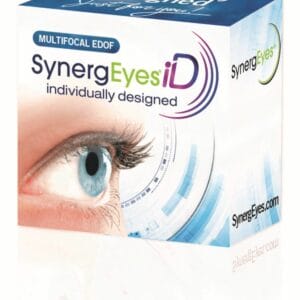April 11, 2023
“Getting old is like climbing a mountain; you get a little out of breath, but the view is much better!” While that quote is from classic film star Ingrid Bergman, I can personally attest as someone in his fifth decade and as an eye care professional that the view certainly does change, specifically changing focus from distance to near.
However, when the lens becomes the deterrent to quality near vision it also means that refractive surgery is not always a great option. More specifically, corneal refractive surgeries are limited in their ability to provide binocular distance and near continuous vision. But, alas, as we age, we realize that we can do without our lens and replace that tired protein-laden sclerotic tissue with a new artificial version, so the age thing is not so relevant.
The Pinhole Effect Extends Both Distance and Near
While this ophthalmic system is so impressive it might be defined as “magical,” you have to admit it is flawed. Why are the layers of the retina backward? Although the lens has the ability to induce just the right convex shape for near focus, it does not last our lifetime. Which is why we look for ways to either change the lens or alter the way we focus at close. To that point, it has long been known that the pinhole effect creates a depth of focus that extends both distance and near. The pinhole effect works by narrowing the peripheral blur and decreases the blur circle on the retina. Since the blur is proportional to the pupil diameter multiplied by the dioptral defocus, the smaller the pupil the greater decrease in blur. This concept has been discussed for the pharmacological treatment of presbyopia but also has extended to the lens.
This concept of the pinhole effect was put to the test by AcuFocus with the Kamra corneal pinhole inlay. This 3.8 mm diameter 5-micron-thick inlay was made of polyvinylidene fluoride (PVDF) and had over 8,400 penetrations in the mask that ranged from 5 microns to 11 microns in diameter. Although the inlay was highly permeable and didn’t disrupt the deep stromal molecular flow or change the corneal curvature, it was the small 1.6 mm central aperture that provided the near improvement. The inlay was not without sequelae, such as inflammatory encroachment on the aperture limiting the clarity and ultimately the near and distance focus for some patients.
Furthermore, the inlay had to be placed deep in the stroma, which meant a skilled refractive surgeon needed enough cornea to provide the best vision. What we did learn from successful patients is that they enjoyed good distance and near vision without glare or halos at night in the Kamra eye. Moreover, the depth of focus induced by the 1.6 mm pinhole absorbed some residual refractive error that these patients may not have had surgically corrected. Thus, the pinhole concept worked great, yet the execution of the inlay was challenging for some corneal types. Lastly, since the inlay absorbed some of the refractive error, it helped improve the near vision without affecting the distance.

FDA-Approved Intraocular Lens for Cataract Patients
In addition to the advantages of aging already established by Ingrid Bergman, we can add the fact that modern technology has afforded us the ability to safely and efficaciously remove and replace this lens. In fact, phacoemulsification through a small aperture is less a surgery than a modern miracle. Few will argue that when the lens is young and viable its performance is seamless, and now we have lenticular options to bring us back to nearly the same accommodative place.
AcuFocus took the pinhole design and married it to a monofocal intraocular lens. The IC-8 is a one-piece hydrophobic acrylic IOL designed to compensate for the focal consequences of peripheral defocused light. The design of the IC-8 IOL enables it to provide 3.00D of extended depth of focus (EDOF), tolerate up to 1.00D deviation from the target manifest refraction spherical equivalent, and accommodate as much as 1.50D of corneal astigmatism.
In addition, this unique IOL can reduce the effects of both lower and higher order aberrations (HOAs), including corneal HOAs such as coma, based on the small aperture effect. The ICL-8 that was FDA approved for patients who have been diagnosed with a cataract is slightly different from the inlay. This hydrophobic acrylic is UV blocking and is 12.5 mm in overall length with a 6.00 mm optic diameter. The non-diffractive aperture (pinhole) is 1.36 mm surrounded by a 3.23 mm diameter PVDF mask. The optimized size of the mask provides both excellent quality of vision and a modulation transfer function superior to that of other multifocal or EDOF lenses.
Some Patients Are Not Good Candidates
As with any procedure there are patients who are not ideal candidates. Avoid eyes with central corneal scarring that overlaps the center aperture and patients with mesopic pupil sizes > 6 mm, since they are more likely to experience dysphotopsias, especially glare. It is also recommended to avoid patients with severe glaucoma, secondary to their existing issues with restricted visual field and contrast sensitivity, monocular patients, patients with vitreous opacity, those with retinal diseases such as AMD, or significant diabetic retinopathy. The absence of unwanted glare and halos, while still providing good functional near vision is an attractive option in any presbyopic offering.
In January of 2023, AcuFocus (including the IC-8) was purchased by Bausch + Lomb and is now being marketed as the IC-8 Apthera IOL. As with any new surgical procedures, optometry will play a critical role in our patients’ success. This lens has advantages that afford patients another option to minimize the trade-off some patients are bound to experience. The removal of the natural crystalline lens and replacement with new lens with modern advantages sure feels like “getting better with age.”





